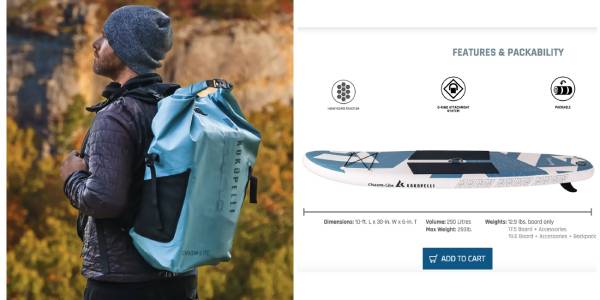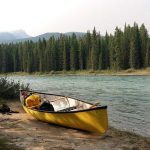The best canoe paddle for you is the one that best suits your needs and preferences. Different paddle designs and materials offer different advantages and disadvantages, so it’s important to figure out what works best for you.
Ultimately, the best paddle is the one that feels the best to you as you move through the water.
Before Settling on a paddle, you should first try out a few different ones. Most paddles will work for most people, but finding the perfect match can make a significant difference. “I ask customers ‘Do you want speed, power, or value,'” says Andrew Stern, marketing manager at Bending Branches.
“Speed means a lightweight paddle for going fast and covering long distances. Power means a durable paddle for rocky rivers and shallow waters. Value means the price is most important. The more you spend on a paddle, the lighter or stronger the paddle is.”
To find the best canoe paddle for you, first determine what kind of paddling you will be doing most often. This guide will help you buy the paddle that works best for you.
The Canoe Paddle’s Purpose
There is no perfect paddle for every situation, just like there is no perfect canoe. Paddle construction, blade shape, and design all vary based on the intended purpose of the canoe.
Flatwater And Tripping Paddles
The Ottertail shape has a flatter blade tip and a wider neck. If you are going to be doing most of your paddling on flatwater lakes, choose an Ottertail or beavertail blade shape. The beavertail shape has a rounded blade tip and a nearly consistent width until it tapers off towards the neck.
The Ottertail shape has a flatter blade tip and a wider neck.
The Ottertail has a blade that is slightly less rounded and narrower. These blade shapes allow the paddle to hold less water on the face of the blade, which can make for less tiring and more enjoyable paddling on extended flatwater trips.
Some people who paddle on long flatwater expeditions or who are focused on speed prefer paddle with a bent shaft.
Stern of Bending Branches says that bent canoe paddles are more efficient than straight paddles. He explains that because the blade can be kept vertical for a longer portion of the stroke with a bent shaft paddle, it requires less effort to move more water. The trade-off is that bent-shaft paddles are awkward to maneuver strokes with.
Whitewater Canoe Paddles
Water paddles with shorter, wider blades and square tips are designed for quick strokes and last-minute maneuvers like draws or prizes. A straight shaft is essential for a whitewater canoe paddle as it makes key techniques like a brace much easier.
-A curved blade on a whitewater paddle helps the blade grip the water better. -Some paddlers will bring a different paddle for flatwater and whitewater sections on a trip.
Solo Canoe Paddles
If you are going to be paddling by yourself, it is best to have a paddle with a longer, narrower blade and a shorter shaft. This will give you more control and precision while you are in the water.
The design of the long blade is such that it stays in the water, with the paddler recovering underwater rather than in the air.
Racing Canoe Paddles
Racing canoe paddles have shorter and wider blades, which catch more water. This allows for paddling at a faster cadence.
Many racing and performance paddlers will also have shafts that are bent, which increases forward power and efficiency for every stroke.
What Features Should I Look For in a Paddle?
- Laminated wood shafts are generally both stronger and stiffer than solid wood.
- Blades with fiberglass resist splitting if they get caught between sharp rocks or piled under duffel bags in the back of your vehicle.
- Particularly with wood, the smoothness of the finish is critical for your comfort.
- Some manufacturers offer high-grade resins along the entire edge of the paddle blade as well as on just the tip. If your paddle sees rough treatment or will be continuously exposed to water on a long trip, you’ll want this type of protection.
- Spar varnish is recommended by some paddle manufacturers for continuous exposure to sunlight, but that gives a softer finish that can pick up fine grit and feel tacky. Polyurethane provides a harder and more durable finish
Canoe Paddle Grips
The two most common paddle grips are the classic palm grip and the T-grip. The palm grip, which is shaped like a teardrop, fits comfortably into the paddler’s hand and is therefore the preferred grip for long flatwater trips and recreational paddling.
The T-grip is less comfortable than the palm grip, but allows for more precision and control. T-grips are most often seen on whitewater paddles, while palm grips are more popular for flatwater paddling.
The Diameter Of The Shaft
The shapes of paddle shafts vary, with some being round and others being oval. Oval shafts can be more comfortable to grip while paddling, but some round shafts have a section that is oval-shaped to provide a better grip.
Canoe Paddle Materials
Wooden Canoe Paddles
Wood canoe paddles are typically chosen by those who paddle in lake water because they are beautiful, feel good in the hands, and are warm to touch in chilly weather. Wood paddles do require some maintenance over time, such as occasional sanding and varnishing to keep moisture and rot at bay.
Ash wood is very durable and a great choice for tripping as it can withstand rough conditions. Maple wood is also strong and flexible. Cherry wood is popular for canoe paddles because it is durable and light.
Walnut is a very stiff and heavy wood, which can also make it more expensive. Some canoe paddles come with a fiberglass tip to protect against impacts if you are paddling in shallow or rocky waterways.
If a wooden canoe paddle has different colors or shades of wood side by side, it is laminated.
Composite Materials
Aramid, Fibreglass, And Carbon Canoe Paddles
Canoe paddles made of composite materials such as carbon, aramid, and fiberglass are almost weightless and very strong. You don’t have to spend time maintaining them like you would with wooden paddles.
Carbon canoe paddles are chosen by racers for their stiffness and lack of flex in comparison to some types of wooden paddles. The amount of carbon in the paddle affects the price, with higher proportions of carbon generally costing more.
Aluminum And Plastic Canoe Paddles
The majority of canoe paddles available are made with a plastic blade and aluminum handle. These paddles are durable and don’t need to be maintained. Some people may not enjoy gripping the aluminum shaft on a cold day as much as they would a wooden one.
Canoe paddles of this type can be less efficient and complex in design than other types, but they can be good to have on a long trip or for occasional canoe outings at the cottage.
How to Size & Choose a Canoe Paddle
There are a lot of technical aspects to choosing the right canoe paddle. Our rule of thumb is for:
- 6-hour trips or less: Economical options are perfectly fine and added features are less necessary.
- 6 hours+/days or longer: All about weight and/or durability and performance.
There is a lot of debate surrounding what is the best paddle length. Many experienced paddlers have a collection of different paddle models and sizes for different conditions. However, most people find the following chart to be effective in sizing new paddlers.
The general rule is that the shortest paddle that allows you to properly reach the water is best. In the middle of their stroke, most paddlers hold the grip so that their top hand is about the height of their nose, and the point where the paddle blade meets the shaft (the throat or shoulder) is at the water line.
Quick Measuring
To measure a paddle while in the field, sit down and place the grip of the paddle between your legs. Mark where the shoulder of the blade hits you. The shoulder on a straight shaft should be at your forehead; the shoulder on a bent shaft should be at your nose.
Canoe Style Notes
If you have a general-purpose, family tandem canoe, you can use the sizing chart below to help you choose the right paddles.
Select a paddle with a shorter shaft for narrow tripping canoes that have inward leaning gunwales or low seats.
Canoes that are extra-wide or have high seats may require a paddle that is slightly longer so that you can reach the water easily with the blade and avoid hitting the shaft (or your knuckles) on the edge of the boat.
How to Size a Canoe Paddle
If you want a canoe paddle that is perfect for the kind of canoeing you want to do, size is more important than appearance.
The size of your canoe paddle is important for comfort and efficiency while on the water. Here are a few of our methods for making sure your canoe paddle is the correct size for you.
The size of your paddle will depend on the canoe you are using and your sitting position. To get the best fit, it is best to try the paddle out in the canoe. If that isn’t possible, there are some sizing methods you can use.
- If you are in the store, kneel on the ground and hold the paddle by its neck with the grip touching the floor in front of you. If the paddle is the correct size for you, your arm should be horizontal.
- Sit in your canoe seat with your feet on the floor and take note of the distance between the water and your nose. This distance should be equal to the length between the grip of the paddle and the paddle’s neck.
- Paddling Magazine’s Publisher Scott MacGregor recommends the precise method of paddling in your canoe on the water with a broomstick. Paddle normally and the section of the shaft that stays dry is equal to the right shaft length for you in that particular canoe. MacGregor likes this method because it takes into consideration the position of your hands, the height of the canoe seat, the depth of the canoe, and how you paddle. After using this method you will just need to figure out the length of blade you want.
- If you don’t yet have a paddle or a canoe at your disposal, you can sit in a chair and determine the distance from the chair to the top of your eyebrows to find out a suitable shaft length for you.
Extra Tips About Your Paddle
Store Your Canoe Paddle Properly
There are many ways to store your paddle, you can find lots of resources online or simply place it flat somewhere in your house or garage. Just be sure to keep it out of the sun and in a dry place over the winter to avoid moisture damage. Remember that storing your canoe is just as important as storing your paddle.
Pack An Extra
Whether you lose your paddle by forgetting it in the bushes at a portage, or having it wash away during the night when the water level changes, it’s not hard to lose your blade.
If you are planning to go on a canoe trip lasting more than one day, remember to pack an extra canoe in case you need it. This will make you much happier and will also please your friends who won’t have to paddle you around.
Make Use Of Hockey Socks For Wooden Paddles
If you’re going on a canoe trip, put a hockey sock over your paddle blade while you’re carrying it or at the campsite. This simple method will protect your wood canoe paddle and help keep it looking good. Many people have their canoe paddles for many years if they take good care of them.
So don’t just choose the cheapest option. A well-made paddle that’s right for your needs and feels good to use is worth the extra cost.




